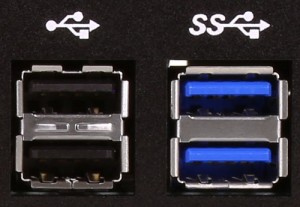


USB 3.2 Gen1: This is the USB 3.0 standard.The USB Implementers Forum consortium (the organization that oversees the development and certification of products) has well thought of re-grouping different standards with the same ending. Again, I think it was a mere marketing issue. However, with the release of version 3.2, things get even more complicated, and the confusion increases. It also gives room for a theoretical transfer speed of 20 Gbps. The USB 3.2 standard was introduced in 2019. This helps because the Quest is constantly tracking the controller positions and the headset position and is.
Usb 2 vs usb 3 difference Pc#
With USB 2 the Quest can either send data to the PC or receive data from the PC but it cant do both at the same time like USB 3 can. In the USB 3.1 Gen2 connectors, you will always find the suffix “Gen2.” In the USB 3.1 Gen1 ports, you can only find the writing “USB 3.1” or the suffix “Gen1.” USB 3.2 Like enigma01 already said, the USB 3.0 spec allows transfer of data up and down at the same time. Put simply, USB Gen1 was just a marketing choice, thanks to which device and PC manufacturers were able to rename their product ports “USB Gen1” when in reality, they were USB 3.0 ports. The Gen1 version is, in fact, identical to the previous one. To do a little more clarity, the true USB 3.1 standard is the Gen2 one. USB 3.1 Gen 2 allows a theoretical transfer speed of 10 Gbps, equal to 7.2 Gbps (900 MB / s). USB 3.1 Gen1 guarantees a theoretical speed of 5 Gbps, therefore the same as version 3.0. It is also available in two types: USB 3.1 Gen1 and USB 3.1 Gen2. However, you should opt for a cable with a newer standard and type when you make your next purchase to ensure optimum performance and the long-term relevance of your devices and cables.The USB 3.1 Super-Speed + standard was introduced in 2013. You don’t need to worry about upgrading your USB Type-A or USB Type-B connectors anytime soon. You don’t need to worry about USB 3 or USB type C rendering one of your devices with an older standard or type useless. USB 3 and USB-C are different things that offer different benefits and aren’t directly comparable. Tabular difference between USB 2.0 and USB 3.0 Transfer Rate, 480 Mbps, 4800 Mbps Data Transfer, 1 Way, Bi-directional Also known as, High Speed USB, Super. If you’ve got a peripheral sitting at home and want to check if it’s equipped with Thunderbolt, check for the Thunderbolt icon near the port of the connector’s plug: USB Jargon Simplified If your device (like a modern Mac) offers Thunderbolt compatibility and you don’t mind splurging a little extra on Thunderbolt-equipped accessories, you should consider investing in a Thunderbolt accessory for top-notch performance. USB 3.1 Gen 2 is capable of 10 Gbps transfer speedsthat’s called SuperSpeed+. At some point, the AC port on your laptops will likely be replaced with a universal alternative.Įven though Thunderbolt offered better performance, it didn’t see a lot of traction because of its high price. USB 3.1 Gen 1, originally known as USB 3.0, is capable of 5 Gbps transfer speedsthat’s called SuperSpeed. With 100 watts of power output, you can use a USB-C PD cable as a charger for your laptop with a USB connection. USB Type-C also supports higher power output when combined with USB PD (i.e., USB Power Delivery). You’ll also be able to plug either end of a USB-C cable into the computer to connect your peripherals, provided the device also has a USB-C port. USB-C’s reversibility will put an end to the classic USB upside-down jokes, but that’s not all. This means that not only can you charge a peripheral device with USB-C cables, but you can also charge your host device using a peripheral when needed.

Here’s the interesting part: USB-C connectors are bi-directional. They’re pretty much the same size as a micro USB connector that you see on mobile devices.
Usb 2 vs usb 3 difference android#
USB Type-C connectors have been around for a while now and are found on modern Android devices, headphones, and gaming consoles.


 0 kommentar(er)
0 kommentar(er)
